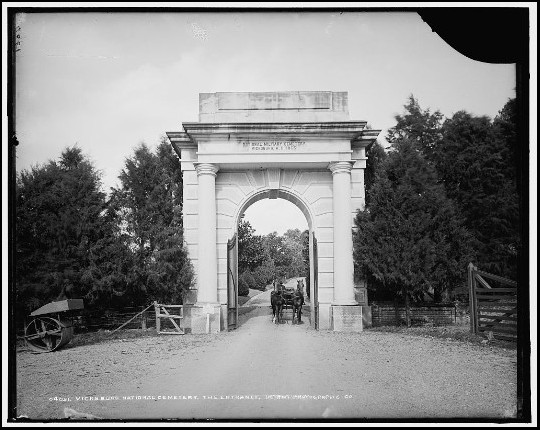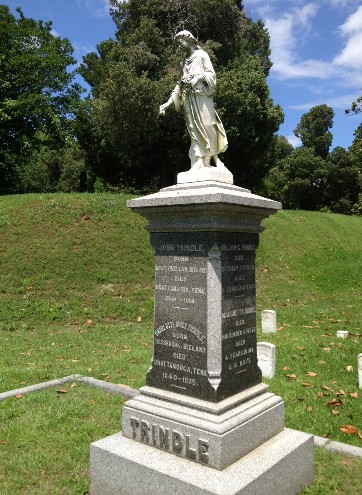John Trindle and the Vicksburg National Cemetery
ECW welcomes guest author Jim Woodrick.
The Vicksburg National Cemetery, composed of 116 acres, is the final resting place for approximately 17,000 Civil War dead, all but two of whom are Union soldiers. Of these, nearly half of the burials are of men who served with the United States Colored Troops. Approximately 75 percent of all the dead at Vicksburg are unknown. The graves of these nameless heroes are marked by small white stones.
In addition to the Civil War dead, there are veterans’ graves from other wars, as well as a smattering of civilians, including park superintendents and their families.[1] The story of one superintendent and his family is particularly poignant.
The Vicksburg National Cemetery was established in 1866, thirty-three years before the national military park was established by Congress. Managed by the War Department, authorities went to great lengths to locate and exhume the thousands of bodies scattered across the battle-scarred landscape in Mississippi, Louisiana and Arkansas. The Federal government paid private contractors to exhume and collect these remains for reburial in the new cemetery at Vicksburg, many of which had been hastily buried along the levees of the Mississippi River or in shallow graves on some lonesome battlefield. As one might imagine, the work was both gruesome and difficult, given the terrain and constant flooding in the region. Despite the conditions, work proceeded, if at an agonizingly slow pace.

To supervise the work not only of the exhumation and reburial of the dead, but of the ongoing construction of the cemetery, the War Department appointed a superintendent. The first full-time superintendent at Vicksburg arrived on September 9, 1868. Scotland native Alexander Henry immediately began working with mortuary records, keeping track of employees and welcoming visitors to the site. Although Henry received several commendations from his superiors for his work, he was suddenly dismissed in September 1874 and transferred to Baton Rouge, in part due to the machinations of the cemetery’s chief engineer, who reported that Henry “was given to periods of excessive drink, and that at times he suffered in consequence from delirium tremens.” [2] Despite being abruptly transferred from Vicksburg, Henry was interred there upon his own death in 1885.[3]
The War Department appointed John Trindle to replace Henry. A Union veteran, Trindle transferred from the Natchez National Cemetery, which had also been established in 1866. Unlike his predecessor, the chief engineer considered Trindle an “intelligent, active, [and] energetic man who gives his whole time heartily and faithfully” to his work.[4]
An Irish immigrant, Trindle enlisted in Co. K, 56th Massachusetts Volunteer Infantry, on June 4, 1864. The regiment was raised late in the war and served in the Overland Campaign and at Petersburg under the command of Col. Stephen Minot Weld.
On Thursday, July 21, 1864, Weld wrote about the position held by the regiment in his diary. “We are now on the front line again, in a pretty fair position,” he penned. “The men have to keep well under cover, however, in order to avoid the fire of the sharpshooters.”[5] Apparently, one of the Confederate sharpshooters found a ready target that day, as Trindle was shot in the left leg and had to have the limb amputated. After being mustered out of the army, Trindle offered his services to the War Department and the growing number of national cemeteries established in the immediate post-war period.
Trindle arrived in Vicksburg in 1874. Just three years later, however, he requested that he be transferred to another post due to the unhealthy climate. “I have been stationed at different Cemeteries in this state and Florida during the last eight years,” he wrote his superiors, “and as a consequence the health standard of my family and myself has been greatly lowered, so much so that there is constantly some of us suffering from the climatic diseases which we have contracted during that time.” Furthermore, Superintendent Trindle claimed that “owing to my disability” the “frequent changes in temperature causes me severe pain in my stump which frequently lasts for days.” The request was denied, however, and Trindle continued his work in Vicksburg.[6]
In 1878, Trindle’s fears for the health of his family became a tragic reality. That summer, a severe yellow fever epidemic swept through the region, and Trindle requested that the cemetery be closed, which was granted by the quartermaster general. Trindle also requested a leave of absence to protect his family from the fever outbreak. On August 12, he wrote Montgomery Meigs that “the health of myself and family is so reduced by sickness that it is believed it would be fatal to have to remain here during the months of September and October.” Enclosed with his request was a statement of support from his physician, Dr. David W. Booth of Vicksburg, who himself succumbed to the disease on August 31.[7]
Trindle’s leave was granted, beginning November 1. By then, however, it was too late. Although his family’s health seemed to improve somewhat in September, disaster struck when both of the surviving children died. On October 11, eight-year-old William George “Willie” Trindle fell victim to the disease, and two weeks later Margaret, age four, also died, leaving the Trindles without any surviving children. Another daughter, Eola, aged one year, had died in mid-August, while a fourth child, Charlotte, died in 1875. All were buried in the Vicksburg National Cemetery.

Despite his personal tragedy, Superintendent Trindle continued to work at Vicksburg. During John Trindle’s administration, the cemetery saw improvements in drainage, appearance, and in the construction of several buildings within the cemetery. On April 12, 1880, Trindle received a distinguished guest at the cemetery; former president Ulysses S. Grant, who visited Vicksburg during a multi-state tour. Grant rode out to the national cemetery, where he was enthusiastically greeted by a crowd of three thousand well-wishers. After complimenting Trindle on the appearance of the cemetery, Grant registered as a visitor and rode back into town. The next day, the Vicksburg paper wrote that the “reception of General Grant in this city was, we are glad to state, entirely free from partisan manipulation.”[8]
In 1881, Trindle received orders to transfer to the national cemetery at Antietam. Although he had earlier hoped to leave Vicksburg, Trindle now expressed his desire to remain in Mississippi. Writing Montgomery Meigs, Trindle stated that “I find it difficult for myself and almost impossible for my wife to sever my connection with the Cemetery.” The request was granted, and Trindle remained at Vicksburg until March 1882, when he transferred to the national cemetery at Chattanooga.
What prompted his change of heart is unknown, but he must have been pleased with his new assignment, as he served as superintendent in Chattanooga until 1910, when he resigned due to declining health. He and his wife remained in Chattanooga until his death on February 13, 1914, of arteriosclerosis at age 73.[9] His burial in the national cemetery was attended by members of the Grand Army of the Republic and the Sons of Union Veterans, who acted as pallbearers. In his obituary published in the Chattanooga News, the writer noted that Trindle was also an honorary member of the Forrest Camp, United Confederate Veterans.[10]

After Trindle’s death, his wife Charlotte continued to live in Chattanooga until age 96, dying on January 15, 1935. Her body, along with her husband John, whose remains were disinterred from the Chattanooga National Cemetery, arrived in Vicksburg on the morning train on January 18, 1935. [11] Both were buried that afternoon in the Vicksburg National Cemetery, reunited in death with their four children. Today, the Trindle family monument, topped by a marble statue of a woman, is notable among the 17,000 veterans buried in the cemetery John Trindle faithfully helped to create. It is a fitting memorial to his dedication and personal sacrifice.

Jim Woodrick is a retired historian with the Mississippi Department of Archives and History. The author of The Civil War Siege of Jackson, Mississippi (2016), he is a former Licensed Battlefield Guide at the Vicksburg NMP.
Endnotes:
[1] Vicksburg National Military Park, “Vicksburg National Cemetery History,” https://www.nps.gov/vick/learn/historyculture/cemhistory.htm
[2] Myers, Richard, The Vicksburg National Cemetery: An Administrative History. (National Park Service, Office of Archeology and Preservation), pp. 38-79.
[3] Vicksburg National Military Park, “Union Interments,” https://nps.gov/vick/learn/historyculture/interments.htm
[4] Myers, Richard, p. 80.
[5] Weld, Stephen M., War Diaries and Letters of Stephen Minot Weld, 1861-1865. (The Riverside Press, 1912), p. 344.
[6] Myers, Richard, pp. 80-81.
[7] Find A Grave (http://www.findagrave.com: accessed May 19, 2025), memorial page for Dr. David W. Booth, (1840–1878), Cedar Hill Cemetery, Vicksburg, MS
[8] Myers, Richard, pp. 97-99.
[9] Ibid, p. 116.
[10] Chattanooga News, Chattanooga, TN. “Capt. John Trindle Obit,” February 14, 1914.
[11] Vicksburg Post, Vicksburg, MS. “Trindles Are Laid To Rest Here Today,” January 18, 1935.
Thank you for your poignant article. We are fortunate to have people such as Mr. Trindle.
Thank you, nice.
Jim, this was so interesting and a glimpse into that time. So enjoyed reading it!
Excellent article Jim!